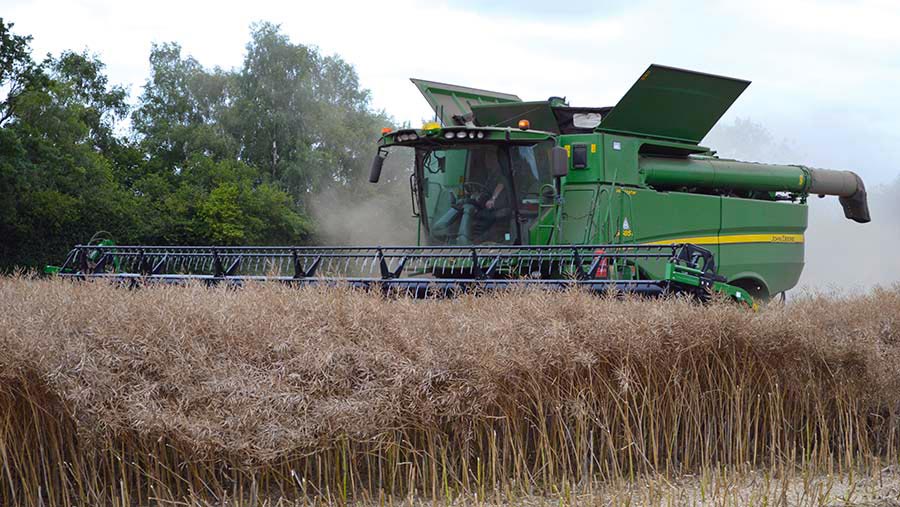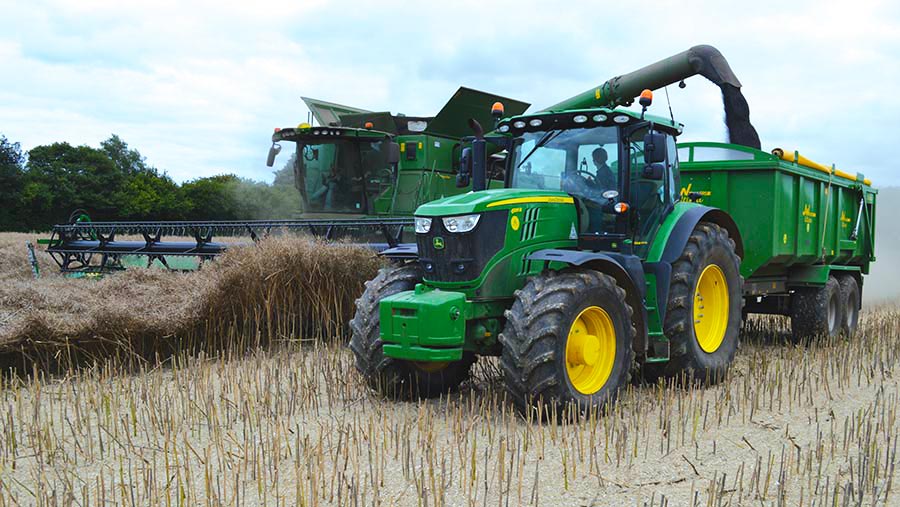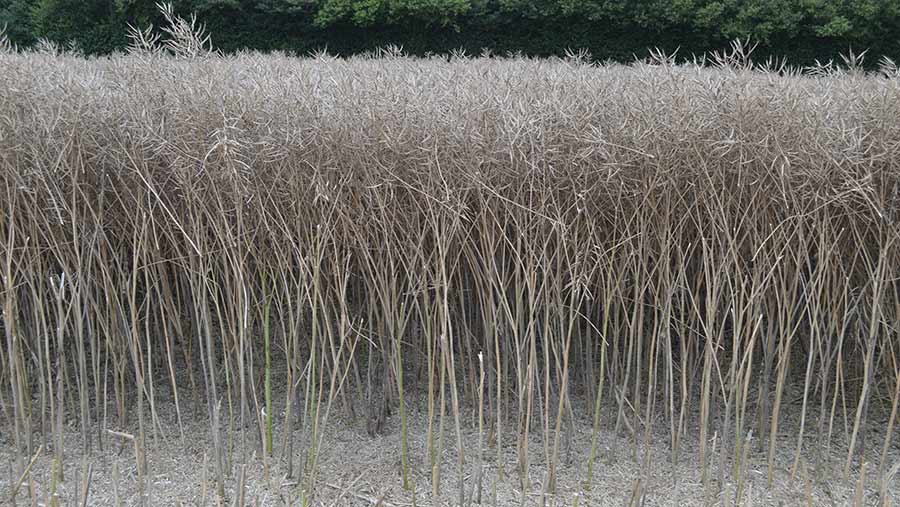Harvest 2023: Some good oilseed rape yields but most are down
 Oilseed rape harvest on Julian Gibbons' farm © MAG/David Jones
Oilseed rape harvest on Julian Gibbons' farm © MAG/David Jones Oilseed rape yields are very variable this season, and although some good yields are being seen the general trend is downwards.
Hampshire grower Julian Gibbons is bucking the early trend in oilseed rape yields, with his hybrid varieties nearly reaching an impressive 5t/ha in a stop-start, rain-affected harvest.
See also: Harvest 2023: Yields hit by early summer drought
While early yields are being seen around 3t/ha, Julian’s crops – boosted by good seed-bed moisture at drilling and crop nutrition – were yielding 4.6-4.8t/ha even after being drilled later than planned in early September.
This is ahead of his five-year average yield of 3-3.25t/ha.
“Our crops established well over winter, and then stayed green for longer up to harvest,” he says.
Many early drilled crops across southern and central England suffered from cabbage stem flea beetle larvae damage. They have tended to ripen early and then shed seeds in July’s storms before giving a disappointing yield.
Hybrid varieties
Julian farms with his brother Andrew growing 50ha of the hybrid varieties Duplo and Aurelia, and with nearly half cut before last weekend’s rains, moisture levels were down at 11.5-12%.
They farm 660ha of silty clay loam soils at Upper Farm, Bradley, about six miles north-west of Alton. In poor years when flea beetle larvae caused bad damage they have seen rapeseed yields fall to as low as 1-2t/ha.
The crops got off to a good start, helped by rain over the August 2022 bank holiday and applications of digestate and sewage sludge. They were drilled on 2-3 September and quickly established.
Even areas of the crop that Julian had nearly abandoned came good and yielded well.
This summer, he will stick with the same two hybrid varieties and use companion cropping to try to lessen the risk of flea beetle damage.

Julian Gibbons’ oilseed rape crop © MAG/David Jones
Finished in Dorset
Further west, Jim Farquharson in Dorset has just finished harvesting rapeseed, cutting 70ha with an average yield of 3.9t/ha.
He farms 800ha at Eastbury Estates, Tarrant Gunville, just north-east of Blandford Forum.
He is pleased with the result, considering the tricky growing season on a farm that typically looks for yields of more than 4t/ha.
Jim has cut the hybrid variety InVigor 1035 at moisture as high as 17-18%, but most was between 10.5-12%.
“This year, we have seen seed knocked out by the summer storms which followed a challenging, dry autumn, so we are not disappointed by the resulting yield,” he says.
Jim has seen some flea beetle damage but has countered the problem by using a buckwheat companion crop, leaving high stubbles in his previous cereal crop and using garlic sprays to keep the pest under control.
Yields down 20%
Further north, Philip Darke, operations director at Camgrain co-operative, described yields as OK to disappointing with good oil level averaging 44.5% and with more than three-quarters of his members’ crops cut across eastern and central England.
United Oilseeds trading manager Owen Cligg says rolling national yields are looking at about 3t/ha, some 20% down on last year and pointing to a lower overall UK crop of 1.2m tonnes.
Oil levels are slightly down in a range of 42-45% and obviously moistures have been higher in the wet harvest.
Many lower early yields across southern England in July were seen due to seed loss from storm damage before harvest, and flea beetle damage earlier in the season.
“The weather has been challenging, and although there is a lot of crop to cut in the North, we see yields down 20% which make for a difficult time for growers with costs going up,” says Owen.
National crop
An average yield of 3t/ha over a UK area of 400,000ha is giving just a 1.2m-tonne crop.
This is down on last year’s 1.36m tonnes – which was from a smaller area but showed better yields – and well below the UK crush industry capacity at 1.8m tonnes from its three crushers in Kent, Liverpool and Stratford.
Traders see smaller total crops in France and Germany, as well as the UK, but plentiful cheap supplies of rapeseed are available from eastern Europe to keep a lid on prices, with UK ex-farm prices currently £365-£370/t.
The AHDB gave its latest estimate of the British oilseed rape area at 402,000ha, up 11% from the previous year, in its July planting and variety survey.
The main factor behind the rise was a spot delivered oilseed rape price of more than £800/t in spring 2022, when planting intentions were being made, with the price driven up by the start of the war in Ukraine.

© MAG/David Jones
Poor pod filling
Oilseed rape expert David Leaper, at crop consultant Agrii, says there are a number of factors hitting oilseed rape yields this season, and he is seeing yields in the 3-3.5t/ha range.
“There was a combination of all sorts of things holding back yields, but the most important was the hot weather at pod fill timing, which limited thousand grain weight,” he says.
After a relatively good flowering period, hot conditions, primarily in June, did limit seed size, while the wet and stormy weather in July will have led to some pod shatter and seed loss.
In addition, some growers saw an extra pest problem this spring in the shape of winter stem weevil to add to problems from flea beetles, and some crops were lost in the spring from these two pests.
For next season, he advises growers to leave long stubble (preferably wheat) to drill oilseed rape into and deter flea beetles.
The wet weather that has hampered harvest should be good for rapeseed establishment and especially companion crops, he adds.
UK oilseed rape crop – Defra official figures |
||||
| Year | 2019 | 2020 | 2021 | 2022 |
| Oilseed rape area (ha) | 530,000 | 380,000 | 306,000 | 384,000 |
| Yield (t/ha) | 3.3 | 2.7 | 3.2 | 3.7 |
| Production (m tonnes) | 1.75 | 1.04 | 0.98 | 1.36 |
| Note: The highest oilseed rape area recorded was 756,000ha for harvest 2012, which produced a 2.56m-tonne crop | ||||
